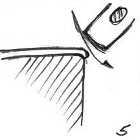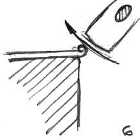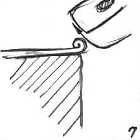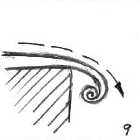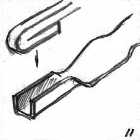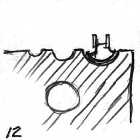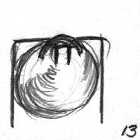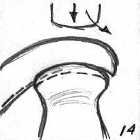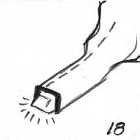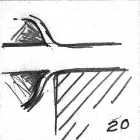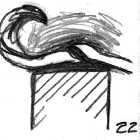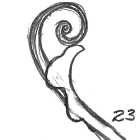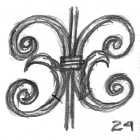guru : |
Tonight's demo will be a double scroll with leaf as made by Peter Ross of Colonial Williamsburg, VA a few weeks ago. This was at an annual Mid-Atlantic Smiths Association meet at the CW Anderson blacksmith shop. We have several pages in the new edition of the anvilfire NEWS about it. | |||
guru : |
|
|||
guru : |
Peter used a couple special tools that you may or may not need. | |||
Dav-e-C : |
Neat! I learned something! ]:p | |||
guru : |
|
|
||
guru : |
Peter is a big proponent of doing everything on the anvil but he used these in the vise. I suspect it was because the vise is higher. . | |||
guru : |
|
The leaf blank | ||
guru : |
I wasn't there when Peter made the blank but I think he forged it from bar. Today we would plasma cut or have them laser cut. Peter was using wrought iron exclusively | |||
guru : |
|
The scroll was made from a 3 foot long piece of 1/2" bar | ||
guru : |
The extra length is for handling. The taper was 12 to 13 inches and the last 2" were about 3/32" thick. | |||
guru : |
|
The scroll is started with glancing rolling blows | ||
guru : |
|
|
||
guru : |
Starting the rolled up end is the hard part of the scroll. It takes practice to make them roll up tight. | |||
guru : |
|
|||
guru : |
On early wrought iron work the rolled "snub" end was the preferred method. | |||
guru : |
|
|
||
guru : |
The scroll is worked progressivly from the end over the anvil. Peter did not use a scroll jig. | |||
guru : |
|
|||
guru : |
The scroll again to see where we are going. I would use a scroll jig. . . | |||
guru : |
|
The leaf weld prep. | ||
guru : |
A piece of bar was folded on itself to make a fit for the leaf. Once close it was finished in the vise. (no pic) | |||
guru : |
|
|
Curling the leaf | |
guru : |
As many smiths do Peter moved from anvil to vise to swage. . . Whatever worked at the moment. | |||
guru : |
|
The hard part. Bending against another bend. | ||
guru : |
|
End view. | ||
guru : |
The leaf was worked a little at atime in this tool and alternatly on the horn of the anvil. | |||
guru : |
|
After the "curved bend", wavyness is added. | ||
guru : |
|
Then the scroll was cut to length where the leaf ends on the bar. | ||
guru : |
|
In preparation for the forge weld the bar is heated first. | ||
guru : |
After the bar was heated to near welding heat and flux applied the leaf was slipped over it an the assemblu went back into the fire. | |||
guru : |
Heating the bar as hot as possible FIRST prevented burning the thin leaf. | |||
guru : |
|
The forge weld. | ||
guru : |
|
After the weld the area was reduced to the bar size. | ||
guru : |
|
A standard bar to bar scarf was then forged. | ||
guru : |
|
A drop tongs weld was then made. | ||
guru : |
|
|||
guru : |
The reason for welding the leaf at the end of the bar and the putting the bar BACK on is to make a seamless joint. If you wrapped the leaf around the bar and tried to blend it in you would always see the end of the joint. | |||
guru : |
This was a little piece of majic that I expect Peter had worked on for some time. . . | |||
guru : |
After welding the bar back on, the length is measured and the bar cut, drawn out and the second scroll forged. | |||
guru : |
|
|
||
guru : |
This was not Peter's usual fast paced demo. He admitted that these were VERY expensive pieces to make. They were reproductions to repair an 18th Century gate. | |||
guru : |
Questions? |
|||
pix : |
Is there a "trick' (re #22) to get forging heat without burning the leaf? | |||
guru : |
Pix, the only "trick" was heating the inner part first and having a very snug fit. | |||
Leah : |
Could you please show the two tools he used again? | |||
guru : |
|
|
||
edgonz : |
when welding the leaf do you heat only the bar, or bar and leaf? | |||
Sharon : |
Presented very well , Jock, Your drawings are Excellent! Was this for a stairrail panel, centerpart of Firetool Stand, or what? | |||
pix : |
After the leaf is welded, when the second half of the bar is welded, or are we talking about the same thing? | |||
guru : |
To weld the leaf, the bar is heated to a near welding heat and fluxed. The leaf is then slipped on and the assembly returned to the fire. With the inside already hot it doesn't take long to bring the leaf up to heat. | |||
Bill-Epps : |
very interesting, how well would mild steel do??? | |||
guru : |
Sharon it was part of a gate. | |||
guru : |
Bill I think mild would do fine but I have trouble rolling the ends that tight in steel. | |||
Leah : |
Any tips on doing the "curve against the curve" on the leaf? | |||
Sharon : |
We have some hardy tools similar to his, but see some other good uses for these two. Bill will just have to get busy and make a couple of these.:) | |||
guru : |
zws, we are posting the logs on a much better schedule now. It will be on the iForge page next week. Leah, when bending against another curve the work must stretch. The trick is to work carefully. This piece took Peter, one od the worlds finest smiths about 3-4 hours. | |||
guru : |
|
There will be a higher res copy of this image posted with the demo. | ||
Ten-Hammers : |
Guru, did they ever weld a "knob" after rolling the end, or was it always visibly rolled? | |||
Bill-Epps : |
how long did it thke peter to make one of these pices???? | |||
guru : |
As you can see, the joint area of the leaf is drawn out well into the taper. Peter studied a bunch of these that were falling apart to see how the originals had been made. Ten, it is often done various ways. But it apears from looking at early work that most wrought was rolled up. With the grain of the wrought this makes a much stronger method. | |||
guru : |
Bill, beteen 3 to 4 hours. And if you've been to one of his demos, you know Peter doesn't stop and talk a lot. . | |||
Ten-Hammers : |
I meant welding the roll after making it Guru. To produce the effect of a knob. | |||
guru : |
It was an intresting contrast. We went from CW and all wrought iron and bellows to blow the forge to Dan Boone's where Michael Wright did a demo starting with plasma cut leaf blanks and using a gas forge. Made for an intresting weekend. | |||
Bill-Epps : |
Jock, Can see doing one of these the "purist way" to show that it can be done, but we just made 200 rolled end scrolls that HAD TO MATCH exactly in uniformity, 100 of 1 size and 100 of another size, and I had 2 days to make them in, so JIGS are the way I have to do it. But I know Peter, and appreciate his talent and skill level. :) | |||
pix : |
guru, in the olden days, was this type of work painted or what? | |||
Bill-Epps : |
Sure proud didn't have to put forged leaves on them, though. | |||
guru : |
Regular scrolls are one thing but I don't think you could speed up the leaf joint a lot on a first class piece of work. Its something I would avoid except at solid gold prices. Pix they had oil based paint in the 1700's. The "lin" in that linsywoolsy is fron the same plant as linseed oil is made from. . | |||

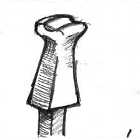


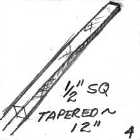 .
.